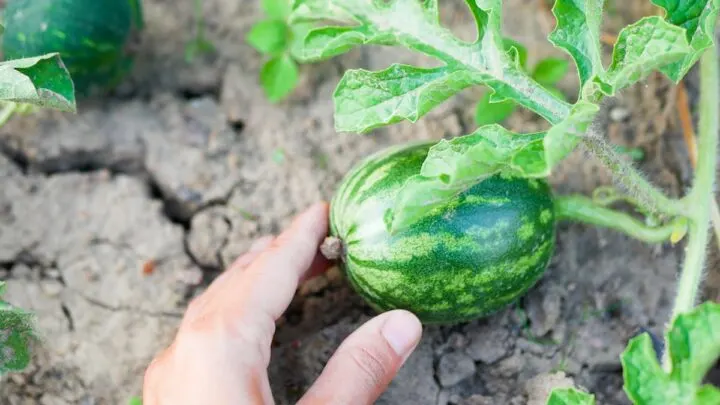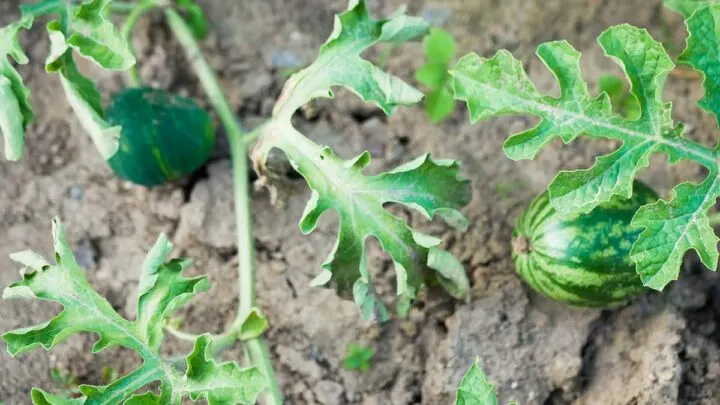Growing watermelon is wonderful, but some diseases come with homegrown melons. You’ve probably run into blossom end rot if you have grown watermelon before. It is a very common disease, and sometimes there’s nothing we can do about it. It is a disease that commonly affects watermelons, though it occurs in many vegetables as well, including tomatoes.
Blossom end rot isn’t a bacteria, a fungal disease, and any insects or pests do not cause it. Blossom end rot is actually what happens when the plant lacks calcium. However, it goes beyond just a calcium deficiency.
Although blossom end rot can’t be reversed on the specific fruit it’s affecting; you can save the other fruit on the plant from getting this disease. Keep on reading to find out other causes and cures for blossom end rot.

What Does Blossom End Rot Look Like?
To identify blossom end rot, first look at the blossom end of the watermelon. It will first appear as a small light brown spot, almost like a bruise. The spot will grow into larger darker colored spots that appear sunken in, dry, and rotted as the fruit grows.
Causes Of Blossom End Rot
I’ve mentioned that the overall cause of blossom end rot is the lack of calcium in the plant. However, specific things help create this lack of calcium in the plant.
Overwatering
Yes, watermelons are heavy water feeders. They need around 1-2 inches of water a week, but it is still possible to overwater watermelons. Overwatering aids in the cause of blossom end rot by drowning out the roots. Nutrients can’t travel through the plant when the roots are drowned. Not only that, but when the roots are soaked, the rot will happen in both the roots and in the fruit.
Underwatering
Underwatering can also cause blossom end rot, among other problems as well. If you let the roots dry up, then you water them suddenly; the plant (which at this point is extremely thirsty) is just taking in the water quickly and leaving the nutrients behind.
Too Much Nitrogen
If you are feeding your plant nutrients, you may have given it too much nitrogen too many times. Blossom end rot will come from the plant’s inability to keep up with the nitrogen in its system, where there isn’t enough calcium to keep up the plant growth.
Curing Blossom End Rot
Unfortunately, once the specific fruit grows and has blossom rot, there is no reversing it. However, there are things you can do to make sure none of the other fruits that will grow in the future get it.
Remove Infected Watermelons
The first you will want to do is remove all of the infected melons from the plant. Even if they aren’t ready to harvest yet, if you leave them on the vine, they will become inedible anyway. Throw out the very underripe melons. If they are almost ripe and there is only a small area of blossom rot, simply remove the rotted part, and you should be able to save the rest.

Add-In Calcium
The next thing you will want to do is pump calcium into your plant. The great thing is that there is no such thing as too much calcium. Give your plants a liquid feed of Cal-Mag or Super Cal to boost the calcium intake. Do this once a week to see results.
Change Watering Habits
Your past watering habits may have been part of the issue and the reason for causing the blossom end rot. Watermelons need 1-2 inches of water a week, and they do not like to ever dry out. However, since overwatering could be part of the issue, make sure you are not overwatering as well.
Try watering once every other day, deeply, so the roots get plenty of water, especially if you live in a dry, hot area. You can put mulch around the base of your plants to keep moisture levels in.
Preventing Blossom End Rot
Luckily, blossom end rot is very preventable. You can take measures to ensure that your watermelons do not get affected by this disease.

Add Calcium
The easiest way to prevent blossom end rot is to make sure calcium levels are good before even planting your plants. Gardeners will often add eggshells to their fertilizer and compost to have a constant flow of calcium circling through the soil.
Adding lime to your soil is another great way to boost calcium levels. As I mentioned above, you can also feed your plants liquid calcium feeds once a week during the plant’s growth to make sure the plant is always getting calcium.
Balanced Water Schedule
We talked about a proper watering schedule above, and it is essential to stick to it. If you have your watermelons directly in the ground, in a row, having your plants on a drip tube water feeder is a great way to make sure your watermelons are getting lots of water right to their roots.
You can also put this drip water tube on a timer, so you never forget to water your plants. The most important thing to remember is 1-2 inches of water a week.
Balanced Fertilizer
Although we’ve talked about how good fertilizer and nutrients for plants are, over-fertilizing can happen, especially with nitrogen. Watermelons need nitrogen, but not too much.
You can feed watermelons nitrogen once every couple of weeks, maybe even every three weeks, just to ensure they are getting some, but they don’t need a lot. Keep your levels balanced, and don’t feed your watermelons more than once a week.
Check Soil pH
The soil pH is important because it is what controls the nutrient levels in the plants. This affects the overall growth of the plant and can control diseases- like blossom end rot. Every plant is different in the level of pH it can tolerate. Watermelons like their soil to have a pH of 6.0-7.0.
You don’t have to check the pH every day, not even every week. But keeping an eye on it is essential. Check it before you plant, then you can check it once a month afterward.
Are Watermelons Affected By Blossom End Rot Edible?
It depends on how badly the watermelon has been affected by the blossom end rot for it to be deemed edible or not. Sometimes, the rot may not be that bad. However, the fruit may not be ripe yet and will taste bad anyway.
This is usually the case. However, if the blossom end rot starts late in the ripening stage, you may be able to harvest your watermelon, cut off the damaged part, and continue eating the rest. You can compost the watermelons infected that are not edible.
Final Thoughts
Blossom end rot isn’t the worst disease, and it is fairly common. Most gardeners will come across blossom end rot at least once in their years of gardening, whether it be on their watermelons, tomatoes, zucchinis, etc. Making sure your plants have good amounts of calcium and are being watered on a good schedule will prevent blossom end rot. Happy gardening!

Hi there, my name is Allie and welcome to my blog; GareningWithAllie!
Much of what you see written here is just our personal experiences with gardening. Along with the content I write here, there is also a unique collection of gardening topics covered by some of our close friends. I hope you find everything you read here to be helpful, informative, and something that can make your gardening journey the most lovely experience ever! With that said, Happy Gardening!
